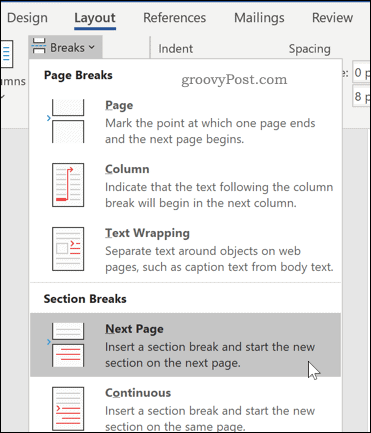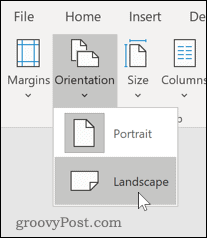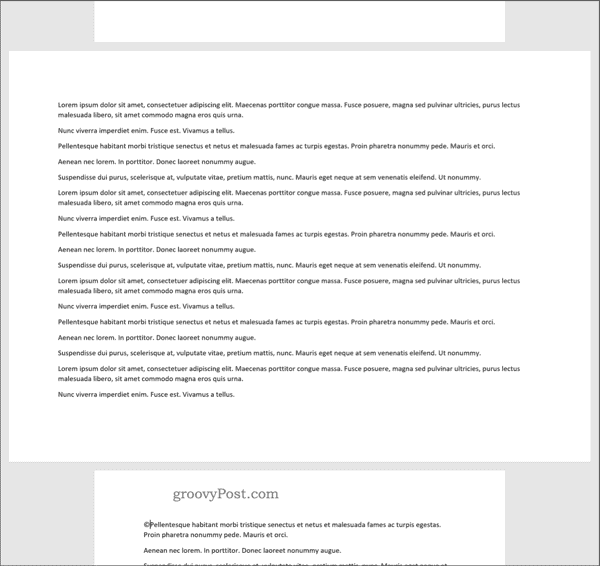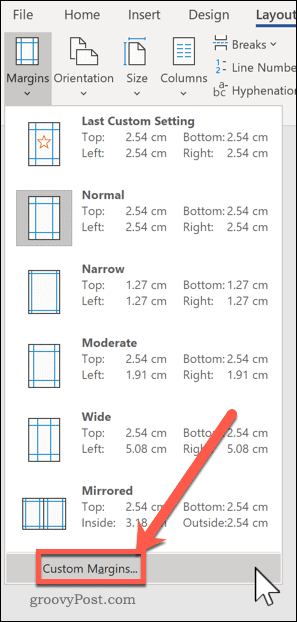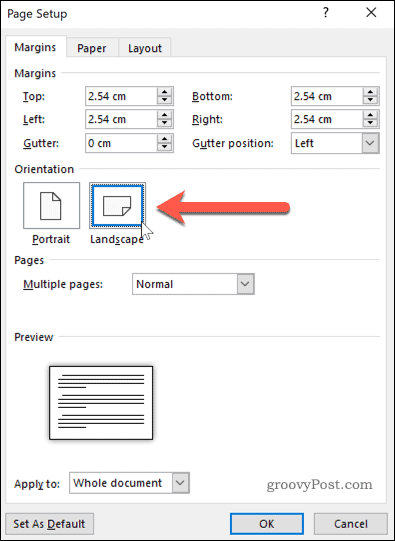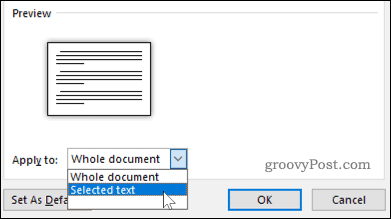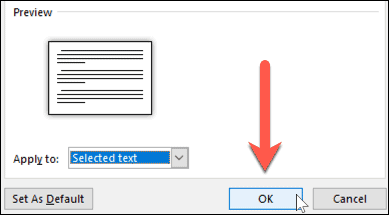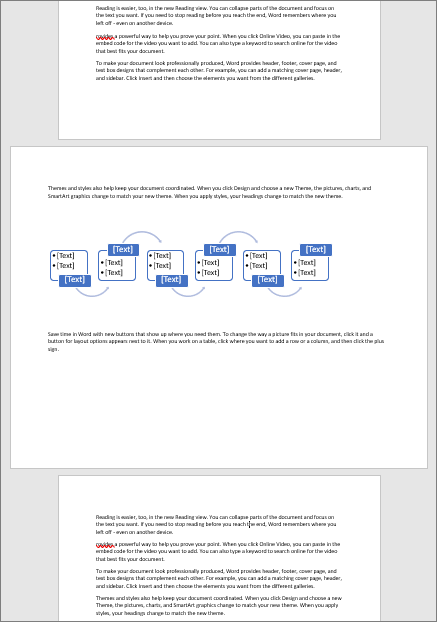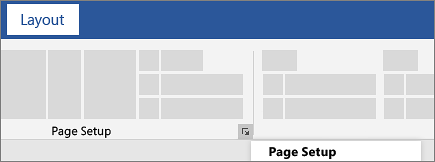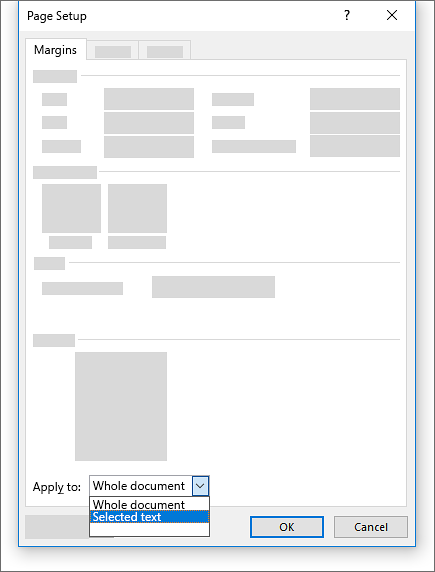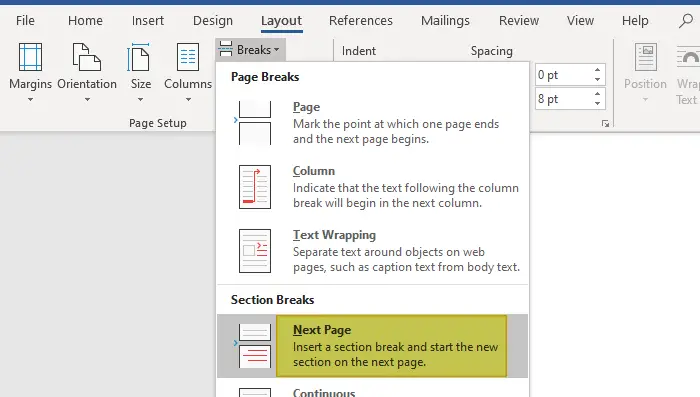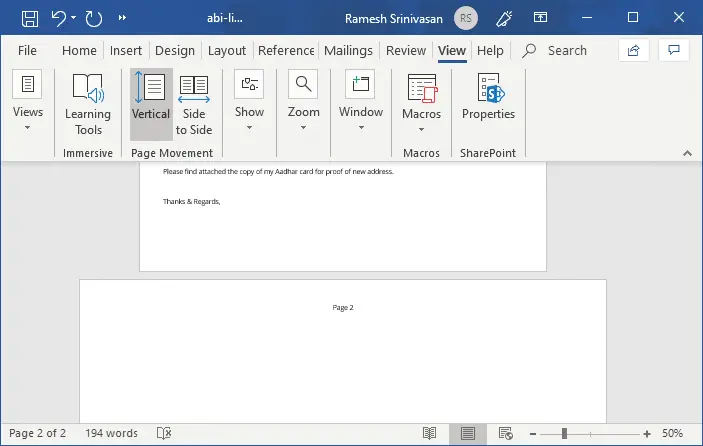If you’re creating a Word document with multiple page layouts, you may wish to make a single page landscape. Here’s how.
Photo Credit — iStockPhoto
When you’re creating Word documents, you have two-page layout options available—landscape or portrait. Portrait mode is the default option, but you can switch to landscape mode instead if you want your text sideways.
If you want to use both types of layouts in Word, you’ll need to use a few workarounds using section breaks and Word’s own page formatting options to do so. Here’s how.
If you want to quickly make one page landscape in Word, here’s what you’ll need to do:
- Open your Word document and place the blinking cursor at the start of the page you wish to change to landscape mode.
- Click on the Layout menu in the ribbon bar.
- Select Breaks > Next Page in the Section Breaks section. This will insert a section break and push your text onto a new page.
- In the Layout menu, press Orientation > Landscape. This will switch the current page and all the following pages to landscape mode.
- You’ll now need to turn the remaining pages back to portrait mode. Scroll down to the next page, then place the blinking cursor at the start of the page.
- Press Layout > Breaks > Next Page to insert a new section break.
- Click on Orientation > Portrait to switch the pages to portrait mode.
If you followed the steps correctly, you should now have one single landscape page, with all other pages remaining in portrait mode.
How to Make Specific Text Landscape in Word
If you don’t want all of the text on your page to appear on the landscape page, you can choose to make a landscape page that only contains specific text.
- To do this, start by highlighting the text that you want to appear on the landscape page.
- In the Layout menu, click on Margins, then select the Custom Margins… option at the bottom of the drop-down menu.
- In the Page Setup window, click on the Landscape option in the Margins tab, under the Orientation section.
- In the Apply to box, choose Selected Text.
- Click OK to confirm the settings you’ve selected.
You should now have a landscape page that contains the text you previously highlighted, creating a section break that uses a different page layout to the rest of your Word document.
You can use this method to turn an entire page landscape—to do this, select all of the text on the page before you start and repeat the steps above to complete the change.
Formatting Microsoft Word Documents
Now that you know how to make a single page landscape in Word, you can start creating documents with as many combinations of landscape and portrait pages as you want. This is where learning how to rearrange pages in Word might just come in handy.
If you’re looking for other ways to take your Word documents further, why not learn how to insert an Excel table into Word. For academic documents, you may wish to create a table of contents in Word to keep your document organized.
Change page orientation to landscape or portrait
Change orientation of whole document
-
To change the orientation of the whole document, select Layout > Orientation.
-
Choose Portrait or Landscape.
Change part of a document to landscape
-
Select the content that you want on a landscape page.
-
Go to Layout, and open the Page Setup dialog box.
-
Select Landscape, and in the Apply to box, choose Selected text.
Need more help?
Want more options?
Explore subscription benefits, browse training courses, learn how to secure your device, and more.
Communities help you ask and answer questions, give feedback, and hear from experts with rich knowledge.
The default portrait orientation on Microsoft Word is useful for most cases. However, when it comes to importing a significantly wider table or image, then the landscape orientation is the only way to go.
Here I will show you how to make Microsoft Word document into landscape quickly.
How to make all pages landscape
1. Launch the document you want to edit or a new blank document.
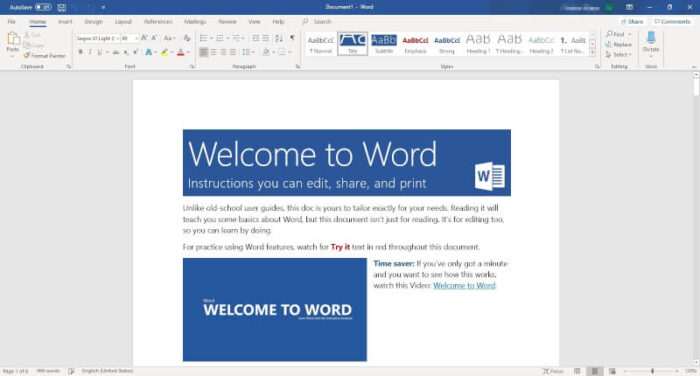
2. Go to Layout > Orientation > Landscape.

3. Now all pages have been converted into landscape. You may need to edit them to make it look neater.
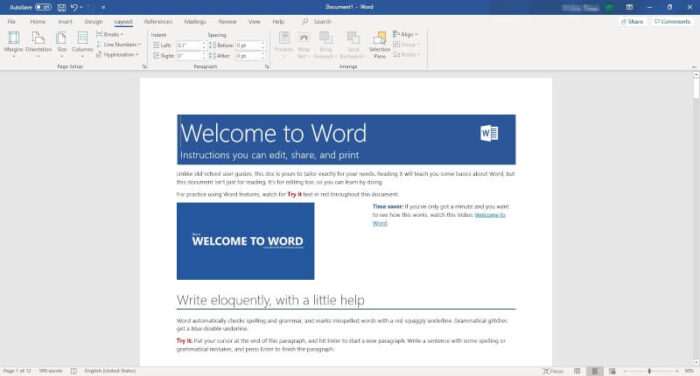
How to make a certain page landscape
1. Select the text from the page you want to turn into landscape.

2. Go Layout > Margins > Custom Margins…
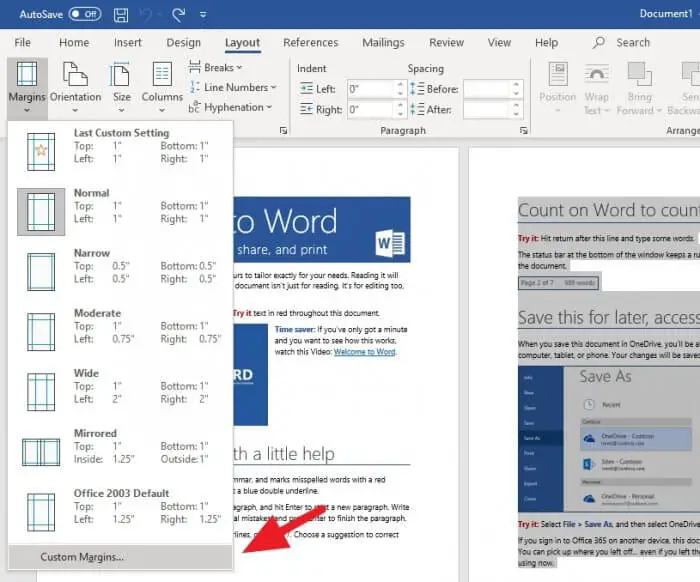
3. Select Landscape and apply to the Selected text. Then, hit OK.
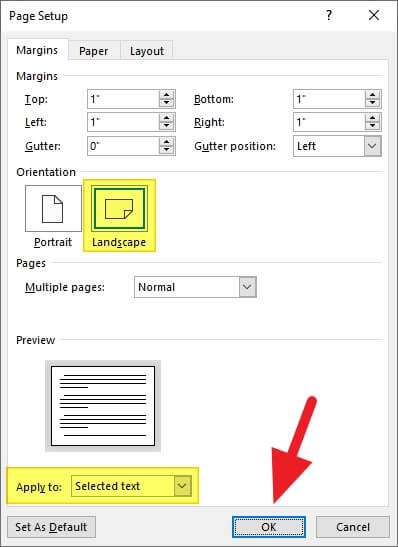
4. Now, that one specific page has turned into landscape.
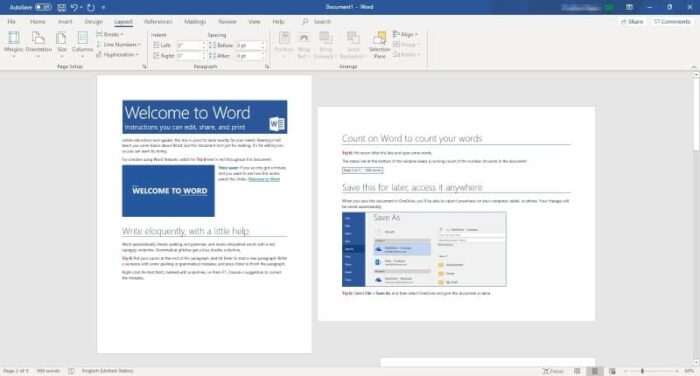
You can do that again to make some pages landscape. After that, save the document.
Download Article
Download Article
This wikiHow teaches you how to change the orientation of a Microsoft Word document from portrait to landscape mode. If you don’t want to rotate the whole document, you can rotate one page by surrounding it with section breaks.
Things You Should Know
- To change a document’s orientation, you’ll need to change the «Page Layout» settings.
- You can rotate a single page by using section breaks.
- When using section breaks, you’ll be able to change the orientation in «Page Layout».
-
1
Open the document in Microsoft Word. You can do this by double-clicking the document on your computer.
- Alternatively, open Microsoft Word first (under All Apps in the Start menu on Windows, or in the Applications folder on macOS), then open the document.
-
2
Click the Layout or Page Layout menu. It’s at the top of the screen. The name will vary depending on your version of Word.
Advertisement
-
3
Click the Orientation menu. A drop-down menu will appear.
-
4
Click Landscape. The entire document is now in landscape mode.
Advertisement
-
1
Open the document in Microsoft Word. You can do this by double-clicking the document on your computer.
- Alternatively, open Microsoft Word first (under All Apps in the Start menu on Windows, or in the Applications folder on macOS), then open the document.
-
2
Click the cursor at the beginning of the page you want to rotate. Clicking right before the first character on the page should do the trick.[1]
-
3
Click Layout or Page Layout. It’s one of the menus at the top of Word. The name you see will vary depending on your version.
-
4
Click the Breaks menu. A list of various types of breaks will appear.
-
5
Click Next Page. It’s under the “Section Breaks” header.
-
6
Click the Layout or Page Layout again.
-
7
Click the Orientation menu.
-
8
Click Landscape. This page (and any that follow it) are now in landscape mode. Since you only want to rotate one page, you’ll just need to add another break at the bottom of the page to convert the remaining pages back to portrait mode.
-
9
Click the cursor at the beginning of the next page.
-
10
Click Layout or Page Layout.
-
11
Click Breaks.
-
12
Click Next Page.
-
13
Click the Orientation menu.
-
14
Click Portrait. The remaining pages after this break will all be in portrait mode, while the page(s) between the breaks will remain in landscape.[2]
Advertisement
Ask a Question
200 characters left
Include your email address to get a message when this question is answered.
Submit
Advertisement
Thanks for submitting a tip for review!
About This Article
Thanks to all authors for creating a page that has been read 43,112 times.
Is this article up to date?
Select the text on the page you want to be landscape in your document, then go to the Layout tab and open the «Page Setup» window. Set the orientation to «Landscape,» and pick «Selected Text» in the drop-down menu.
By default, Microsoft Word orients its pages in portrait view. While this works fine in most situations, you may have a single page that would look better in landscape view. Here are two ways to make one page landscape in Word.
Change One Page to Landscape With Page Setup
The quickest and easiest way to convert a page from portrait to landscape in Word is to select the content and turn only that page. This method works with text, images, tables, and other items you have on the page.
RELATED: Tables and Other Formatting Controls
Select all items on the page. If you have text, drag your cursor through all of it. If you have an image, table, chart, or another type of object, simply select it.
Go to the Layout tab and click the arrow on the bottom right corner of the Page Setup section of the ribbon. This opens the Page Setup dialog box.
Confirm that you’re on the Margins tab. Below Orientation, choose “Landscape.” Then at the bottom, click the Apply To drop-down box and choose “Selected Text.” Click “OK.”
When the dialog box closes, you will see your page turn to landscape view.
Make One Page Landscape by Inserting a Break
While the above method is the simplest, you may run into difficulties if you have different types of items on your page. For instance, you might have an image or table with text wrapped around it.
Although you can select all the content on the page, it may display on more than one page when you change the orientation. Luckily, there is another way to make one page landscape in these situations using a section break.
Place your cursor at the start of the page you want to change before any text or items.
Go to the Layout tab, click the Breaks drop-down arrow, and choose “Next Page.” This inserts a section break in your document.
Stay on the Layout tab, click the Orientation drop-down arrow, and pick “Landscape.” This changes the current and all subsequent pages to landscape view.
To return the remaining pages to portrait view, go to the next page and place your cursor at the beginning of the content.
Go to the Layout tab, click the Breaks drop-down arrow, and choose “Next Page.” This inserts another break in your document.
Now on the Layout tab, click the Orientation drop-down arrow and pick “Portrait.”
You’ll then see the remaining pages turn back to portrait view, leaving the one page you chose in landscape view.
If you use Google Docs as well as Microsoft Word, you can change the page orientation in Google Docs just as easily.
READ NEXT
- › 7 Reasons to Use Your Monitor in Portrait Mode
- › Universal Audio Volt 2 Review: A Workhorse Audio Interface With Vintage Charm
- › Why One Ultrawide Is Better Than Two Monitors
- › The Best DNS Servers for Secure Browsing
- › Get to Your Windows 11 Desktop: 7 Fastest Methods
- › Why the Right-Click Menu in Windows 11 Is Actually Good
- › Google+ Will Come to a Final End on July 5, 2023
How-To Geek is where you turn when you want experts to explain technology. Since we launched in 2006, our articles have been read billions of times. Want to know more?
Let us make you familiar with page orientation of Microsoft Word, and page orientation can be defined as how your document will be displayed or printed. There are 2 basic types of page orientation:
- Portrait (vertical) and
- Landscape (horizontal)
Lately, while writing a document in Word, I came across a clumsy problem where I had about 16 pages in the document and the middle somewhere I needed a page to be in Landscape orientation, where rest is all in portrait. Changing one page to landscape in MS Word is not a discerning task. But for this, you have to be well-known with concepts like section breaks.
Usually, Word documents have an orientation of page as portrait or a landscape. So, the question comes how to mix and match two orientations under the same document. Here are the steps and two methods explained in this article about how to change the page’s orientation and make One Page Landscape in Word.
Method 1: Insert section breaks for setting the Orientation manually
You can manually inform Microsoft Word to break any page rather than let the program decide. You have to insert a ‘Next Page’ section break at the start and end of the picture, table, text, or other objects for which you are changing the page orientation.
1. Click at the beginning of the region where you want the page to rotate (change orientation).
3. Choose the Layout tab from the “Breaks” drop-down and select “Next Page”.
Repeat the above steps at the end of the area you want to rotate, and then continue.
Note: The section breaks and other formatting features can be visible using Ctrl+Shift+8 shortcut key, or you can click the Show/Hide Paragraph Marks button from the “Paragraph” section in the “Home” tab.

Now you should have a blank page in the middle of two pages of content:

1. Now bring your cursor on that particular page where you want the different orientation.
2. Open the “Page Setup” dialog box window by clicking the tiny arrow sited in the lower right corner of the “Layout” ribbon.

3. Switch to the “Margins” tab.
4. Select either “Portrait” or “Landscape” orientation from the Orientation section.
5. Pick an option from the “Apply to:” drop-down at the bottom of the window.
6. Click, OK.
Method 2: Let Microsoft Word Do It for You
This method will save your clicks if you allow MS Word to insert ‘section breaks’ automatically & do the task for you. But the intricacy in letting Word put your section breaks arises when you select text. If you do not highlight the whole paragraph, the unselected items such as several paragraphs, tables, images, or other items will be moved by Word onto another page.
1. First, select the items you’re planning to change in the new portrait or landscape orientation.
2. After selecting all the images, text & pages, you want to change to the new orientation, choose the “Layout” tab.
3. From the “Page Setup” section, open the “Page Setup” dialog box by clicking the tiny arrow sited in the lower right angle of that section.

4. From the new dialog box, switch to the “Margins” tab.
5. Select either “Portrait” or “Landscape” orientation.
6. Pick Selected Text from the “Apply to:” drop-down list at the bottom of the window.
7. Click “OK”.
Note: The hidden breaks and other formatting features can be visible using Ctrl+Shift+8 shortcut key, or you can click the backward P button from the “Paragraph” section in the “Home” tab.

Recommended:
- How to Switch Between Browser Tabs Using Shortcut Key
- Forcefully Clear the Print Queue in Windows 10
- How to Fix Monitor Screen Flickering Issue
- Disable Indexing in Windows 10 (Tutorial)
I hope the above steps helped you learn How to Make One Page Landscape in Word, but if you still have any questions regarding this tutorial, please feel free to ask them in the comment’s section.
Have you ever been putting together an essay or report and wanted to include a large image? Maybe a nice graph or chart? The answer is to put it on a page in landscape, or horizontal, layout. So you try that, but then all the pages go to landscape.
Here’s the fastest, easiest way to make one page landscape in Word.

Also, feel free to check out the video we posted to our YouTube channel below, where we walk you through the same steps as in this article, just with an accent!
HOW TO MAKE A SINGLE PAGE LANDSCAPE: In Word
The Point & Click Way To Make One Page Landscape In Word

- Select the image or text that we want to be on a landscape-oriented page.
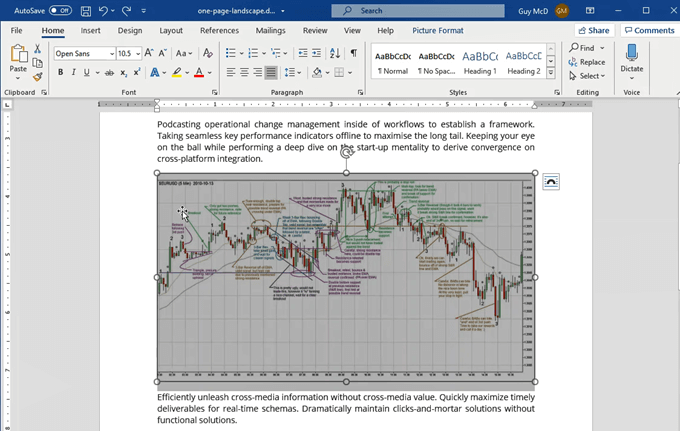
- Click on the Layout tab.

- Click on the down arrow under the Margins button.
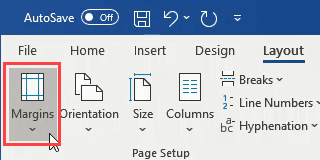
- Click on Custom Margins…
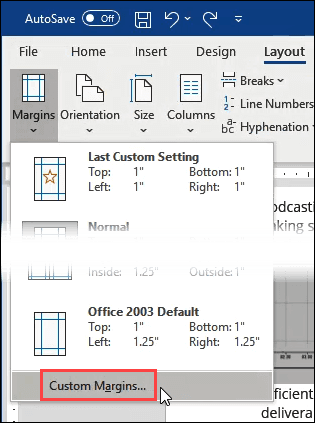
- In the middle of the Page Setup window, click on the Landscape button.
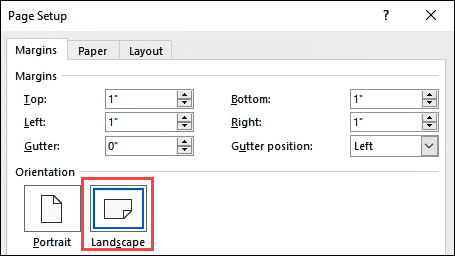
- At the bottom of the Page Setup window, in the Apply to: select box, change it to Selected Text. Click OK.
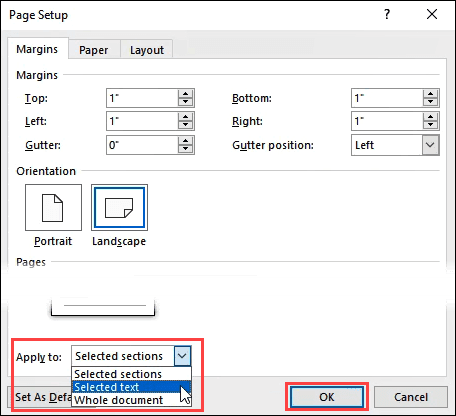
The selected image or text will now be on its own landscape-oriented page. Resize the chart for the best fit and we have a beautiful report.

As simple as that is, it can be done more quickly using keyboard shortcuts. Let’s go through how to use keyboard shortcuts to make the one-page landscape in Word.
The Fastest Way To Make One Page Landscape In Word
How much faster is this method? I timed myself using the point-and-click method and the shortcut keys-only method. Once I had practiced the shortcut keys a few times, it took less than 30 seconds, whereas the point-and-click method took closer to a minute.
Using shortcut keys to do your most frequent tasks not only saves time, but it can also save your health. Much peoples wrist pain from work is caused by using the mouse. The other added bonus is you’ll look like a superstar at work. You’ll be doing things in seconds when others take minutes.
Even though it may look like there’s more work, it’s just broken down to be very precise. A lot of people have never used shortcut keys in this way and we don’t want them getting frustrated and giving up because we missed anything.
- Select the image or text that we want to be on a landscape-oriented page.
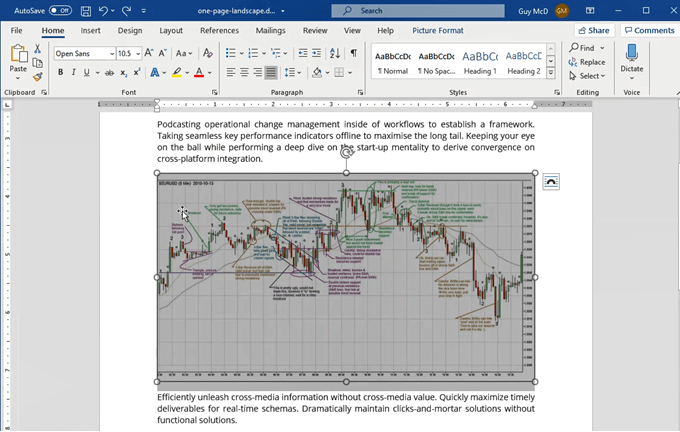
- Press the Alt key then press P to take us from the Home tab to the Layout tab.

- Press the M key to open the Margins button dropdown.
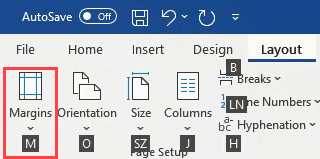
- Press the A key to choose the Custom Margins… and open the Page Setup window.
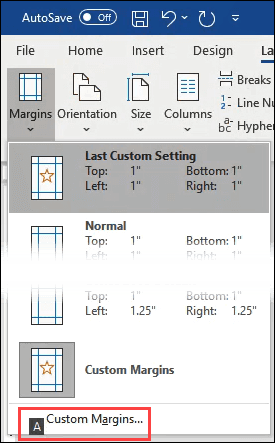
- Press Alt + S to choose Landscape orientation.
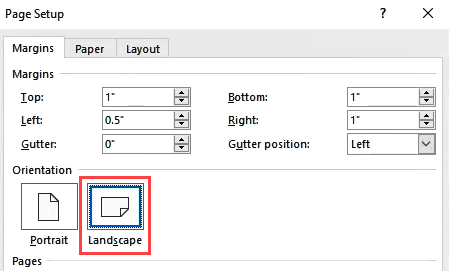
- Press Alt + Y to choose the Apply to: field, then tap the down arrow key once to choose Selected Text. Tap the Enter key once to set Selected Text as the choice, then tap Enter again to apply the setting.
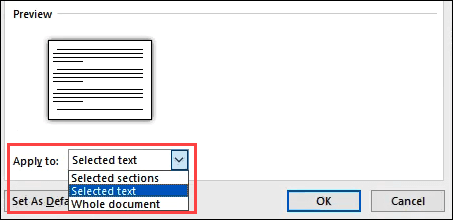
The Page Setup window will close and the text or image will now be on a landscape layout page.

If you like how much faster the shortcut keys were, take a look at our other articles showing the magic of shortcut keys. You’ll wonder how you survived without these top 10 keyboard shortcuts for Windows 10. If you wish there was a shortcut for something, you also might be able to create custom keyboard shortcut for it in Windows 10.
Got some great shortcuts to share? Or questions about other ways to do tough things in Office or Windows? Pop it in the comments below. We’re all here to learn.
To change the Word document orientation, you may have been using Page Setup to change the orientation to landscape or portrait for the entire document. Many users don’t know that Word also allows you to set a different orientation (landscape or portrait) for different pages within the same Word document.
This article tells how to make specific pages in your Word document to landscape and the rest of the pages to portrait orientation, or vice versa.
Use Landscape Orientation for Selected Pages in a Word Document
To make a single page to landscape in Office Word, follow these steps:
- Set the mouse cursor at the beginning of the page (e.g., Page #2) which you like to set to landscape.
- From the Layout (or Page Layout) tab, click Breaks and select Next Page under the Section breaks section. Selecting this option inserts a section break and starts the new section on the next page.
- Click the Orientation button, and select Landscape from the drop-down.
Now all the subsequent pages (e.g., Page 2 onwards) will have the landscape orientation.
Page 1 in portrait mode; page 2 is in landscape.
In case you want to flip Page #3 and subsequent pages to Portrait, bring the cursor to the top of page 3. Insert a section break at the cursor position, as you did earlier. Then, select the Portrait option under Orientation.
Header/footer disappears or the page number resets after the section?
In the earlier versions of Word, adding a section break and flipping a page to landscape may cause the header or footer disappear in that page and subsequent pages. Or the page number may reset to #1.
To fix the problem, go to the footer of your landscape page, and on the ribbon (Design | Navigation), select Link to Previous. This should place the footer text back. Repeat the same for the header.
To set continuous page numbering, highlight the page number in the header or the footer. Right-click on it and select Format Page Numbers. Select the Continue from previous section option.
Hope this tip was useful to set different orientations for different pages in the same Word document.
One small request: If you liked this post, please share this?
One «tiny» share from you would seriously help a lot with the growth of this blog.
Some great suggestions:
- Pin it!
- Share it to your favorite blog + Facebook, Reddit
- Tweet it!
So thank you so much for your support. It won’t take more than 10 seconds of your time. The share buttons are right below. 
Ramesh Srinivasan is passionate about Microsoft technologies and he has been a consecutive ten-time recipient of the Microsoft Most Valuable Professional award in the Windows Shell/Desktop Experience category, from 2003 to 2012. He loves to troubleshoot and write about Windows.
Ramesh founded Winhelponline.com in 2005.


